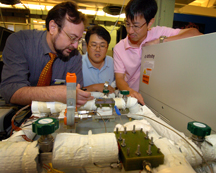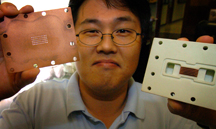
| RELATED INFO |
| * Issam Mudawar |
| * International Electronic Cooling Alliance |
| * Boiling and Two-Phase Flow Laboratory |

July 1, 2008
Chip-cooling technology achieves 'dramatic' 1,000-watt capacity
WEST LAFAYETTE, Ind. - |
New technologies will be needed to meet the cooling needs of future chips that produce more heat than current microprocessors. Conventional computer chips generate about 100 watts per square centimeter, peaking in small hot spots that can damage or destroy the delicate circuitry inside microchips. The chips are air-cooled with finned metal plates called heat sinks and often a small fan.
High-performance chips generate far more heat than conventional technologies, said Issam Mudawar, a professor of mechanical engineering who is leading the research.
Other experimental liquid-cooling techniques are limited to a cooling capacity of about 200 watts per square centimeter, Mudawar said.
"In many ways, progress in the computer and electronics industries is becoming increasingly defined by how well you can cool chips," he said. "We have been stalled for several years at the current level of being able to cool at the rate of about 200 watts per square centimeter. We have hit a plateau, a limit."
The new microjet technology is capable of cooling chips that produce more than 1,000 watts of heat per square centimeter, Mudawar said.
 |
"Here we have opened the envelope significantly," he said. "Getting up to 1,000 watts per square centimeter is dramatic and creates so much room now for advances in performance."
Findings were detailed in a research paper presented during the 11th Intersociety Conference on Thermal and Thermomechanical Phenomena in Electronic Systems, or ITherm 2008, in Orlando, Fla., in May. The paper was written by Mudawar and doctoral student Myung Sung.
"We are proposing a new innovative scheme for achieving unprecedented temperature control capabilities for future defense electronics," Mudawar said.
The Purdue-developed technique circulates a cooling liquid called a hydrofluorocarbon, which is a "dielectric," meaning it will not conduct electricity or cause short circuits.
The cooling system is made of grooves narrower than a millimeter, or thousandth of a meter, wide. These channels are formed on top of a chip and covered with a metal plate containing tiny holes. The coolant is pumped through the holes in microjets, and the liquid then flows along channels to cool the chip. As the liquid is heated by the hot chip inside the channels, it bubbles and momentarily becomes a vapor, facilitating the cooling process, Mudawar said.
The research, funded by the U.S. Office of Naval Research, could lead to a new chip-cooling technology for applications such as advanced radar and propulsion systems and lasers. The approach also might have commercial applications in personal computers, Mudawar said.
The technology is called a hybrid system because it uses a combination of two cooling methods: the microchannels and microjets. In past research using microchannels, the temperature of the coolant varied depending on its location as it moved through the channel.
"That's because the coolant flowed from one end of the channel to the other, heating up along the way," Mudawar said. "By the time the liquid reached the end of the channel, it was hotter than when it began. The microjets allow you to cool uniformly because you are supplying the liquid in the form of jets everywhere along the length of each channel."
Uniform cooling helps to prevent any portion of a chip from overheating. The coolant collects at both ends of the channels and is circulated back through the system.
Hydrofluorocarbons are used in modern air conditioning and refrigeration systems because they are not harmful to the ozone layer in the earth's atmosphere, and they have low global-warming effects. The type of hydrofluorocarbons used in air conditioning, however, is vapor at room temperature, whereas the type used in the experimental chip-cooling system is a liquid.
Hydroflurocarbons are not efficient coolants because they conduct heat at a far lower rate than water. Liquids such as water that readily conduct electricity could cause electrical shorts, whereas dielectric liquids do not.
"Usually, with hydrofluorocarbons, you are barely able to cool at a rate of 200 watts per square centimeter, but this hybrid design boosted the performance dramatically," said Mudawar, who is director of the International Electronic Cooling Alliance and the Boiling and Two-Phase Flow Laboratory, both at Purdue.
Mudawar has developed the cooling technique with mechanical engineering doctoral students Sung and Jaeseon Lee.
Several research papers about the technology have been published in journals, and recent findings were discussed during an Office of Naval Research workshop and conference, the 2007 Thermal Management Program Review in Hilton Head, S.C.
"The work at Purdue shows promise for enabling high-power electronic systems for propulsion, pulsed-power weapons and sensor arrays," said Mark S. Spector, program officer for advanced naval power systems at the Office of Naval Research. "The rapidly increasing use of electronics in military hardware is resulting in unprecedented thermal management needs. The Office of Naval Research, in partnership with academia and industry, is investigating innovative methods to acquire, transport and dissipate waste heat loads that could exceed 1,000 watts per square centimeter."
Writer: Emil Venere, (765) 494-4709, venere@purdue.edu
Sources: Issam Mudawar, (765) 494-5705, mudawar@ecn.purdue.edu
Mark S. Spector, ( 703) 696-4449, mark.spector@navy.mil
Purdue News Service: (765) 494-2096; purduenews@purdue.edu
PHOTO CAPTION 1:
Mechanical engineering professor Issam Mudawar, from left, and doctoral students Myung Ki Sung and Jaeseon Lee survey their design that uses a new type of liquid-cooling approach for computers and electronics. The new technique uses "microjets" to supply a liquid coolant into tiny channels on top of microchips, cooling five times better than today’s high-performance systems. (Purdue News Service photo/David Umberger)
A publication-quality photo is available at https://www.purdue.edu/uns/images/+2007/mudawar-cooling.jpg
PHOTO CAPTION 2:
Purdue mechanical engineering doctoral student Myung Ki Sung displays a plate containing holes for "microjets," left hand, and a device containing "microchannels," both used in a new design that has been shown to dramatically increase cooling for microchips in computers and electronics. The technology circulates a liquid coolant supplied through the microjets into the microchannels and is capable of cooling chips that produce 1,000 watts of heat per square centimeter, about a five-fold increase over the capacity of today’s high performance cooling systems in computers and electronics. (Purdue News Service photo/David Umberger)
A publication-quality photo is available at https://www.purdue.edu/uns/images/+2007/mudawar-coolingplate.jpg
Single-Phase and Two-Phase Hybrid Cooling Schemes for High-Heat-Flux Thermal Management of Defense Electronics
Myung Ki Sung and Issam Mudawar
Boiling and Two-Phase Flow Laboratory (BTPFL) and Purdue University International Electronic Cooling Alliance (PUIECA) Mechanical Engineering Building, 585 Purdue Mall West Lafayette, IN 47907-2088, U.S.A.
This study examines the cooling performance of two hybrid cooling schemes that capitalize upon the merits of both micro-channel flow and jet impingement to achieve the high cooling fluxes and uniform temperatures demanded by advanced defense electronics. The jets supply HFE 7100 liquid coolant gradually into each micro-channel. The cooling performances of two different jet configurations, a series of circular jets and a single slot jet, are examined both and numerically and experimentally. The single-phase performances of both configurations are accurately predicted using 3D numerical simulation. Numerical results point to complex interactions between the jets and the micro-channel flow, and superior cooling performance is achieved by optimal selection of micro-channel height. The two-phase cooling performance of the circular jet configuration is found superior to that of the slot jet, especially in terms of high-flux heat dissipation. Unprecedented cooling fluxes as high as 1,127 W/cm2 are achieved with the circular jets without incurring CHF.
To the News Service home page
If you have trouble accessing this page because of a disability, please contact Purdue News Service at purduenews@purdue.edu.
